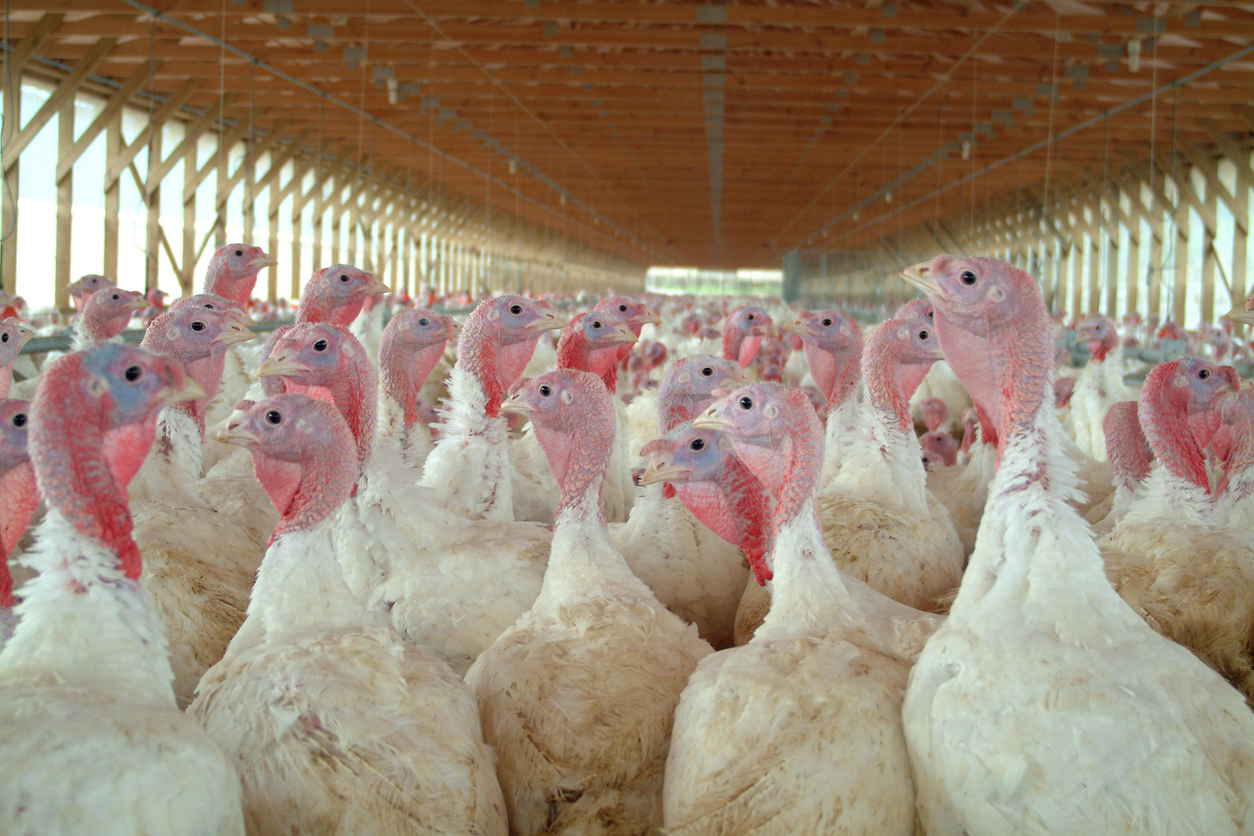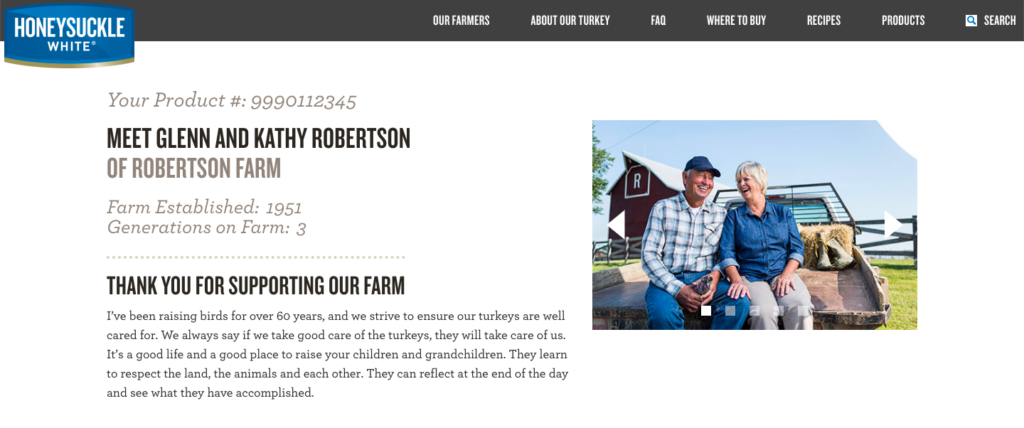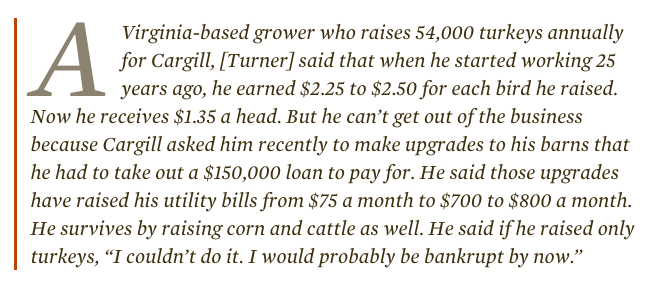New Food Economy: Why Cargill’s “blockchain-based” turkeys obscure more than they reveal
by Sam Bloch and Joe Fassler | November 21st, 2018
Most Americans have no direct contact with agricultural production. And while blockchain could collect reams of data that might interest more engaged farm-to-table eaters, Cargill isn’t necessarily tracking that information.
Last year, Cargill—one of the world’s largest agribusiness companies, a sprawling multinational that maintains a global network of grain processing, meatpacking, and commodities trading operations—announced that it was going farm-to-table. Just in time for Thanksgiving, the company announced it would pilot a run of 60,000 “blockchain-based” turkeys, birds that it said provided an unprecedented level of transparency and accountability.
By punching in a code stamped to their shrink-wrapped, store-bought Honeysuckle White brand turkey, tens of thousands of customers could “get to know the exact family farmer” who raised their holiday centerpiece. The codes allowed producers to track their “family farm-raised fresh, whole” bird back to the state and county where it was raised, view photos of the farm, and even read a message from the farmer.
“We know consumers are looking beyond farm-to-table marketing promises to better understand where their food comes from and how it is produced,” said Deborah Socha, a Cargill brand manager, in a press release. “That’s why the Honeysuckle White brand is the first and only major turkey brand to pilot a blockchain-based solution for traceable turkey.”
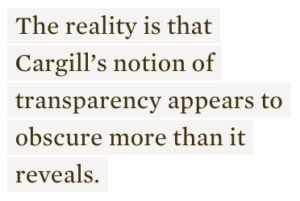 At least from a marketing standpoint, the experiment was a success. This year, Cargill is doubling down for the Thanksgiving season, expanding traceability to 200,000 turkeys grown on 70 farms, representing one-tenth of the company’s 700 turkey growers. What’s still not clear is whether Cargill’s program provides the kind of transparency Americans really seem to want, or whether it’s just a dose of clever, futuristic-sounding PR.
At least from a marketing standpoint, the experiment was a success. This year, Cargill is doubling down for the Thanksgiving season, expanding traceability to 200,000 turkeys grown on 70 farms, representing one-tenth of the company’s 700 turkey growers. What’s still not clear is whether Cargill’s program provides the kind of transparency Americans really seem to want, or whether it’s just a dose of clever, futuristic-sounding PR.
The process starts on Honeysuckle White’s Cargill-operated website. Customers at select stores in the Midwest—and those purchasing the limited supply on Amazon—can punch in their “Meet Your Farmer” code and find their turkey’s origin farm. Here’s an example of what they’ll find: a short webpage that names the farmer, provides a brief testimonial, and pulls up the farm’s location on Google Maps.
For the rest of us, another Cargill website, 700reasons.com, extends the campaign, offering plenty of snapshots. Under a banner reading “Meet our 700 independent family farmers,” we’re treated to photos and videos of Cargill’s producers in their natural habitat. They can be seen smiling on the back of a flatbed truck, smiling in the turkey shed, and smiling in front of the tractor. In videos, they rise at the crack of dawn. They come home from war. They work glorious rolling fields where kids chase the chickens. They have red barns. In dozens of short testimonials, these farmers extol the joys of family, farming, and performing their generations-old duty of feeding the world.
“We’ve devoted our lives to this, and doing our very best keeps the turkeys’ best interest in mind,” write Tom and Kim, a couple pictured leaning against the back of a sea-green Dodge pickup. In one video, a Missouri farmer named Glenn is given a surprise appreciation party at his farm. A pep band marches out of his barn as confetti bombs pop and a huge “THANK YOU, GLENN” banner unfurls.
“I just wish all farmers could see how they’re appreciated,” he says, tears in his eyes.
It’s a humanizing sentiment, to be sure. Most Americans have no direct contact with agricultural production, and never get to know the names and faces of people who grow and raise their food. But the question remains: When people say they want to “know where their food comes from,” what are they really saying? Do they really mean they want to know the farmer’s name, town, and postal code? Or are they hungry for a deeper connection?
Cargill’s answer to that question is surprisingly literal. According to a company survey—which Cargill declined to share in full with The New Food Economy—88 percent of consumers want brands to be more transparent, and 80 percent of consumers feel it’s important to buy a Thanksgiving turkey raised by a “family farmer.” Taken at face value, the transparent turkey rollout would suggest that Americans just want birds they can connect with a name and face, plus the reassurance that it came from a folksy, everyday kind of place, down the proverbial road.
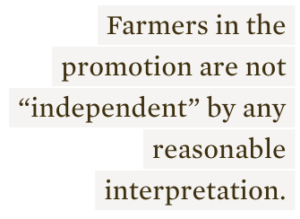 But the reality is that Cargill’s notion of transparency appears to obscure more than it reveals. A customer with concerns about animal welfare, husbandry practices, environmental sustainability, or farmer compensation won’t find answers by punching in a 10-digit code.
But the reality is that Cargill’s notion of transparency appears to obscure more than it reveals. A customer with concerns about animal welfare, husbandry practices, environmental sustainability, or farmer compensation won’t find answers by punching in a 10-digit code.
Blockchain, the distributed digital ledger that tracks Cargill’s turkeys from farm to shelf, can tell you a lot about logistics, and the details of when and where a turkey was shipped or processed. Because that information can be broadly tracked, and made visible to the company’s retail and distribution partners, it has real uses. Especially when it comes to food safety. Were all the turkeys in America tracked via the blockchain, it could conceivably make it easier to prevent outbreaks of foodborne illness. The Centers for Disease Control and Prevention (CDC) recently announced a long-term, ongoing outbreak of Salmonella linked to turkey products—while also acknowledging that it has no idea where the pathogens are coming from. Blockchain, adopted at scale, could make tricky outbreaks less mysterious.
Still, Cargill isn’t offering the public anything close to blockchain’s full transparency capability. Most people have heard about blockchain in the context of banking and cryptocurrency, where the ledger of transactions is available to the public. If you buy or sell Bitcoin, for example—and right now, many are selling—anyone can see those transactions at sites like BlockExplorer. Cargill’s blockchain isn’t like the Bitcoin version. The public can’t see raw data, and the company controls the flow of information. Debra Bauler, the chief information officer for Cargill’s protein and salt divisions, told The New Food Economy that the company’s internal blockchain only stores limited data to be used for this traceability program. As a buzzword, blockchain has powerful associations with notions of radical transparency—overtones Cargill is surely aware of. But the company’s use of the technology, as far as civilian eaters are concerned, is mostly opaque.
Then there’s the fact that blockchain isn’t really equipped to provide certain kinds of information. It leaves out questions that go beyond the basics of where and when—questions that get into the how and why. The 10-digit code might tell select customers the name of the “independent family farmer” who grew their turkey. But Cargill’s presentation of this information leaves a lot out, too. The reality is that the farmers in the promotion are not “independent” by any reasonable interpretation. Their relationship with Cargill is both closer and more complicated than the word would suggest.
These farmers are contract growers, which means they do not own the birds they raise. Cargill does. The company drops off the birds as poults, and picks them up when it’s time for slaughter at a Cargill packing plant. Cargill also owns and ships the feed. Farmers do grow on land they rent or own, and they own their barns. But they’re completely dependent on Cargill to earn a living, an arrangement that leaves little room for autonomy.
Poultry growers are at the mercy of their contracts with meatpackers. The terms are binding, and so-called integrators like Cargill can still cancel them—and stop delivering new birds entirely—unless producers play by their rules, which include committing to cycles of expensive facility upgrades. That arrangement isn’t unique to Cargill: It’s common in the poultry industry, where meatpackers wield all the power, and are often accused of exploiting it.
The finer points of these arrangements, which have real-world implications, aren’t part of Cargill’s vision for transparency, and they can’t be explained through blockchain. Consider the plight of Billy Turner, a Virginia turkey grower whom Politico profiled to explain the impacts of industry consolidation on individual farmers:
Turner’s story isn’t on 700reasons.com, and all the technology in the world isn’t likely to change that. Cargill may use terms like “independent” to humanize its producers, but that language, in the industry, is code for “contract.” To the public, it means one thing. But to Cargill, the word is strategic. It leaves out its own role in the process, and elides the enormous power the company wields over farm families. In fact, the entire Honeysuckle White site is designed to minimize Cargill’s visibility; throughout, its name appears only in fine print. For a company that would seem to pride itself on transparency, it isn’t a good look.
Cargill seems to unintentionally emphasize that point by running a parallel website for its other, non-traceable, turkey brand, Shady Brook Farms. To the casual grocery shopper, Honeysuckle White and Shady Brook could give the appearance of being two separate companies. Except for the logo and color palette, their websites are eerily similar, down to the “turkey with a purpose” tagline. Their respective YouTube channels feature differently branded versions of the same videos. That’s no accident. It’s all just Cargill—the largest privately-held company in America.
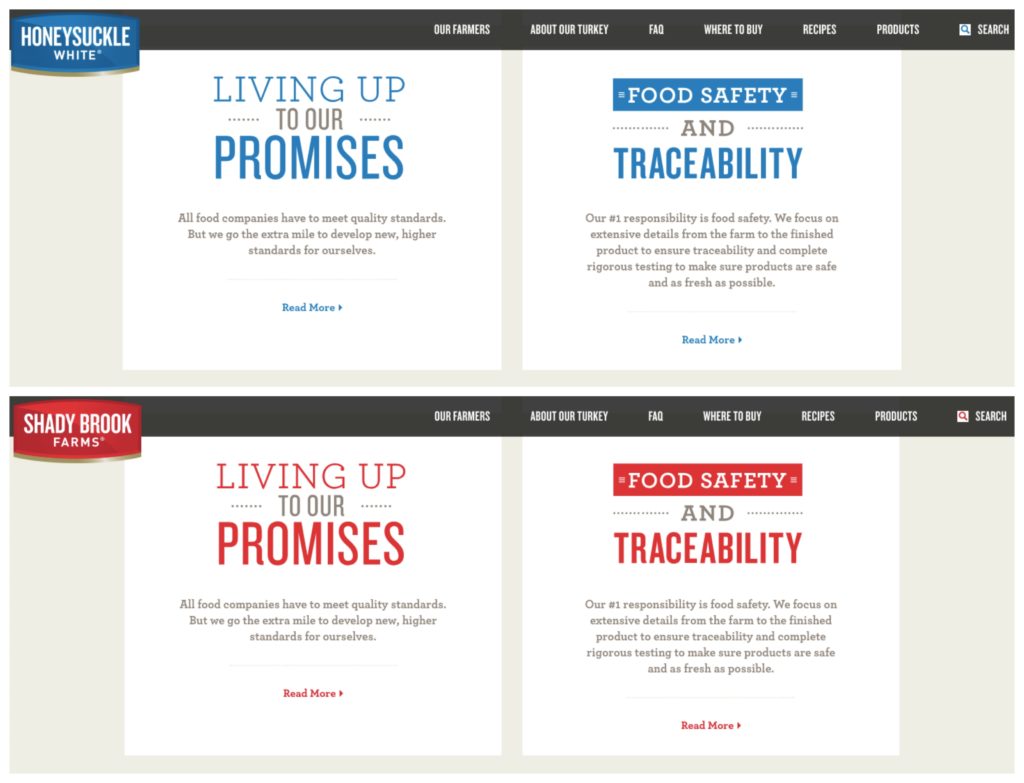
Cargill
Websites for two of Cargill’s turkey brands, side-by-side. Both emphasize “family farms” and make little mention of Cargill, which is one of the country’s biggest meat producers
While the blockchain could, in theory, collect reams of data that might be of interest to more engaged farm-to-table eaters—data about farm compensation and resource usage and bird mortality—Cargill isn’t necessarily tracking that information. Or, if it is, it’s not making that information publicly available. Why not? Because it’s not what Cargill customers want to know, says Kassie Long, a company brand manager. Instead, she says, company surveying has shown that what’s most important to customers is knowing more about the company’s farmers. But will customers really be reassured by knowing that some family farmer—any family farmer—grew their bird?
That’s certainly possible. It’s possible these customers have a warped idea of what factory farming really looks like—that it’s conducted by robots, and not actual people spread across a vast supply chain. Perhaps they don’t know that family farms make up 99 percent of the sector—so the presence of a photogenic couple tells us very little about the economic, environmental, and political realities that explain a product’s origin. Perhaps Americans simply don’t know how to ask more substantive questions about what they eat.
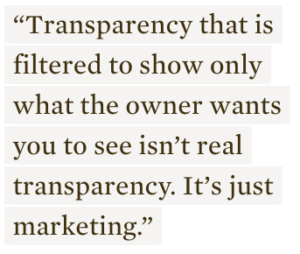 Still, it would still seem that, for many, transparency is about more than mere geography, or searching for a farm the way you’d look up a restaurant on Google Maps. It’s just as likely that Americans say they want to know where their food “comes from” because they’re aware that eating means making choices—choices that start to look starkly different when you follow the supply chain back beyond the plate. There are meaningful questions to ask about issues like animal welfare, labor, environmental sustainability, and corporate consolidation. But Cargill’s notion of transparency doesn’t provide information on any of those topics. It simply pretends those considerations don’t exist. That approach might be blockchain-enabled, but it’s not blockchain in spirit.
Still, it would still seem that, for many, transparency is about more than mere geography, or searching for a farm the way you’d look up a restaurant on Google Maps. It’s just as likely that Americans say they want to know where their food “comes from” because they’re aware that eating means making choices—choices that start to look starkly different when you follow the supply chain back beyond the plate. There are meaningful questions to ask about issues like animal welfare, labor, environmental sustainability, and corporate consolidation. But Cargill’s notion of transparency doesn’t provide information on any of those topics. It simply pretends those considerations don’t exist. That approach might be blockchain-enabled, but it’s not blockchain in spirit.
“Consumers want full transparency. They don’t just want to see a photo of a family farmer and assume that’s true,” says Jacy Rittmer, co-founder of Bytable Foods, which helps food companies implement blockchain tracing. “They want the full truth, and whether they know what that means or not, we’re not sure. But transparency that is filtered to show only what the owner wants you to see isn’t real transparency. It’s just marketing.”
Blockchain technology really does provide new opportunities for transparency, allowing companies to track and share information with unprecedented specificity and accountability. But until the technology engages customers in a more meaningful way on substantive questions, it won’t be groundbreaking. There’s another, less exciting term for what Cargill’s transparency campaign really is: good old-fashioned advertising.
